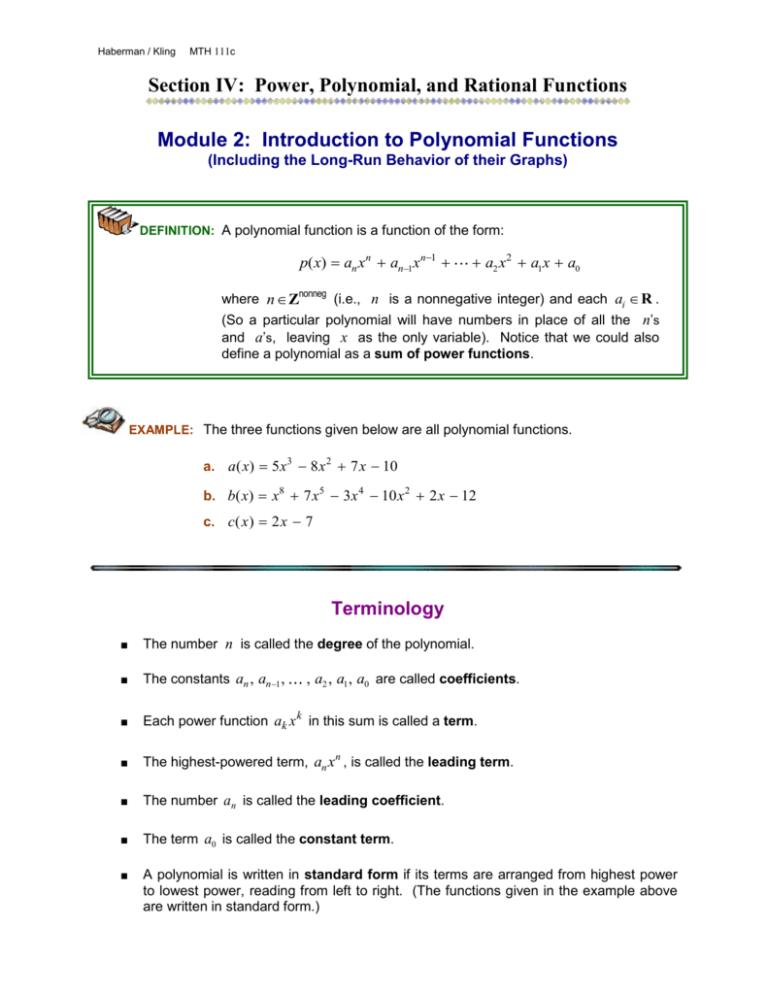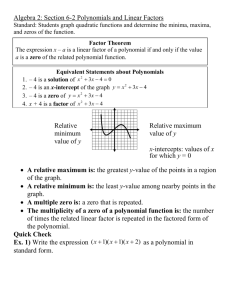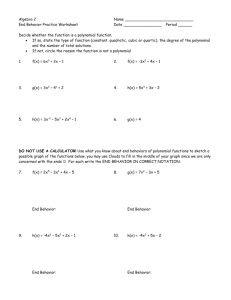Module 2: Intro to Polynomial Functions
advertisement

Haberman / Kling MTH 111c Section IV: Power, Polynomial, and Rational Functions Module 2: Introduction to Polynomial Functions (Including the Long-Run Behavior of their Graphs) DEFINITION: A polynomial function is a function of the form: p( x) an xn an1xn1 a2 x2 a1x a0 where nZnonneg (i.e., n is a nonnegative integer) and each ai R . (So a particular polynomial will have numbers in place of all the n’s and a’s, leaving x as the only variable). Notice that we could also define a polynomial as a sum of power functions. EXAMPLE: The three functions given below are all polynomial functions. a. a( x) 5 x3 8 x 2 7 x 10 b. b( x) x8 7 x5 3x 4 10 x 2 2 x 12 c. c( x ) 2 x 7 Terminology ■ The number n is called the degree of the polynomial. ■ The constants an , an1 , ■ Each power function ak x k in this sum is called a term. ■ The highest-powered term, an xn , is called the leading term. ■ The number an is called the leading coefficient. ■ The term a0 is called the constant term. ■ A polynomial is written in standard form if its terms are arranged from highest power to lowest power, reading from left to right. (The functions given in the example above are written in standard form.) , a2 , a1 , a0 are called coefficients. 2 EXAMPLE: Consider f ( x) 5 x 8 x 7 x 10 . This 3 2 3rd degree polynomial function is written in standard form. The leading term is 5x3 , the constant term is –10, and the coefficients are 5, –8, 7, and –10. Like power functions, polynomial functions are defined for all x R , so the domain of a polynomial function is R , the set of real numbers. Except for degree zero polynomials (whose graphs are horizontal lines), the graphs of polynomials do not have vertical or horizontal asymptotes. Polynomial functions have extremely “nice” graphs since they are smooth and continuous. (If a graph is smooth then it has no sharp points and if it is continuous it has no gaps and no jumps). Key Point: Polynomial functions are smooth and continuous. Their graphs have no sharp corners, no gaps, and no jumps. EXAMPLE: The graphs in Figure 1 represent polynomial functions. Notice that these graphs are smooth and continuous since there are no sharp corners, no gaps, and no jumps. Figure 1 EXAMPLE: The graphs in Figure 2 do NOT represent polynomial functions since they are not smooth and continuous. The first graph has a gap. The second graph has a jump. And the third graph has sharp corners. Figure 2 3 Based on your previous coursework, you should already know a great deal about 2nd degree polynomial functions, whose graphs are parabolas. Let’s consider a 4th degree polynomial function and then compare it to what we know about parabolas. 4th degree polynomial function 4 3 2 g ( x) 3x 2 x 5 x 7 x 13 . Let’s investigate the behavior of the EXAMPLE: Consider the function when the input values get extremely large. Below, we evaluate the function g for large x-values. We’ve colored the leading term blue and all of the other terms purple in order to expose the dominance of the leading term when the x-values are sufficiently large. g (100) 3 1004 2 1003 5 1002 7 100 13 300, 000, 000 2, 000, 000 50, 000 700 13 300, 000, 000 2, 049,313 302, 049, 313 g (1000) 3 10004 2 10003 5 10002 7 1000 13 3, 000, 000, 000, 000 2, 000, 000, 000 5, 000, 000 7, 000 13 3, 000, 000, 000, 000 2, 004, 993, 013 3, 002, 004,993, 013 g (10, 000) 3 10, 0004 2 10, 0003 5 10, 0002 7 10, 000 13 30, 000, 000, 000, 000, 000 2, 000, 000, 000, 000 500, 000, 000 70, 000 13 30, 000, 000, 000, 000, 000 2, 000, 499,930, 013 30, 002, 000, 499, 930, 013 What we can see above is that the leading term is MUCH larger than all the other terms when the x-values are large. (In fact, as the x-values get larger, the leading term represents a larger and larger fraction of the output value. Mathematicians often say that the leading term dominates the other terms of the polynomial when the x-values are sufficiently large. In fact, when viewed on a large enough scale, the graph of the polynomial function p( x) an xn an1 xn1 a2 x2 a1x a0 looks like the graph of its leading term, the power function y an xn . behavior of the polynomial. This behavior is called the long-run Key Point: The long-run behavior (i.e., as x ) of the graph of a polynomial function is determined by its leading term. Thus, the leading term of a polynomial function is the dominant term when the inputs are increase or decrease without bound (i.e., get large in absolute value). 4 EXAMPLE: Compare the graphs of g ( x) 3x 2 x 5 x 7 x 13 and h( x) 3 x . 4 3 2 4 SOLUTION: First, notice that h( x ) 3 x 4 is the leading term for the function g ( x) 3x 4 2 x3 5 x 2 7 x 13 , so what we are really trying to do in this example is compare the graph of a function with the graph of its leading term. The three graphs in Figure 3 (below) show g ( x) 3x 4 2 x3 5 x 2 7 x 13 (in blue) and h( x) 3x 4 (in red) at different scales. (We “zoom out” farther and farther from left to right.) Figure 3: Graphs of y g ( x ) and y h( x ) with different scales. Notice that as we zoom out, it becomes harder and harder to distinguish the graphs of g ( x) 3x 4 2 x3 5 x 2 7 x 13 and h( x) 3x 4 , which confirms what we observed numerically: the long-run behavior is dominated by the leading term. (Notice that in the last graph, the two functions appear to be virtually identical!) Let’s take a second look at 2nd degree polynomial functions. We know that the graphs of quadratic functions with positive leading coefficients are parabolas opening upwards. Compare that to the graph of g ( x) 3x 4 2 x3 5 x 2 7 x 13 . The graph of g has similar long-run behavior as quadratic functions with positive leading coefficients! In fact, any even degree polynomial with a positive leading coefficient has similar long-run behavior as quadratic functions with positive leading coefficients. What do you think the graph of k ( x ) g ( x ) where g is defined in the example above? If you answered, “a reflection of the graph of y g ( x ) about the x-axis,” you are right (and you remember something about transformations of functions!). The graph of y k ( x ) has similar long-run behavior as quadratic functions with negative leading coefficients. In fact, all even degree polynomials with negative leading coefficients have similar long-run behavior. Check out the example below. 5 EXAMPLE: The long-run behaviors of the graphs of a ( x) x , b( x ) 3 x 2 x , 2 4 3 and c( x) x 6 x5 x 4 x3 are similar since they are all even degree polynomial functions with positive leading coefficients. The graphs of these functions (below) confirm this conclusion. Figure 4 : a ( x) x 2 , b( x) 3 x 4 2 x 3 , and c( x) x 6 x5 x 4 x3 Now let’s consider odd degree polynomials. We’ll start by studying a 3rd degree polynomial. EXAMPLE: Consider k ( x) x x . Below, we evaluate the function 3 2 k for large x- values. We’ve colored the leading term blue and the other term purple. k (1000) 10003 10002 1, 000, 000, 000 1, 000, 000 1, 001, 000, 000 k (10, 000) 10, 0003 10, 0002 1, 000, 000, 000, 000 100, 000, 000 1, 000,100, 000, 000 k (100, 000) 100, 0003 100, 0002 1, 000, 000, 000, 000, 000 10, 000, 000, 000 1, 000, 010, 000, 000, 000 Once again, we see that for large values of x, the leading term is the dominant term. Thus, the long-run behavior of k ( x) x3 x 2 should resemble the long-run behavior of q( x) x3 . Let’s look at the graphs of these functions. 6 The three graphs in Figure 5 (below) show k ( x) x3 x 2 and q( x) x3 at different scales. (We “zoom out” farther and farther from left to right.) Figure 5: Graphs of y k ( x ) and y q( x ) with different scales. Notice, yet again, that as we zoom out, it becomes harder and harder to distinguish the graph of k ( x) x3 x 2 and the graph of it’s leading term q( x) x3 , verifying that the long-run behavior of a polynomial is determined by the leading term. Notice that the longrun behavior of the graph of k can be summarized symbolically as follows: As x , k ( x ) . As x , k ( x ) . It turns out that all odd-degree polynomials have similar long-run behavior (just like all even-degree polynomials have similar long-run behavior). One class of odd-degree polynomial with which you are already familiar is degree-1 polynomial functions (i.e., linear functions). The long-run behavior of a linear function with a positive leading coefficient (i.e., with a positive slope) is similar to the long-run behavior of k ( x) x3 x 2 and q( x) x3 (i.e., the graph shoots “up” towards the right and the graph shoots “down” towards the left. In fact, the long-run behavior of any odd degree polynomial function with a positive leading coefficient is similar to the long-run behavior of a linear function with positive slope. Similarly, the long-run behavior of any odd degree polynomial with a negative leading coefficient is similar to the long-run behavior of a linear function with negative slope. 7 EXAMPLE: Which of the following could be the algebraic rule for the function graphed in Figure 6? Figure 6 a. f ( x) x3 2 x 2 7 b. g ( x) x 6 5 x3 2 x 7 c. h( x) 2 x3 3x 2 2 x 7 d. j ( x) 3x 4 2 x3 x 2 7 SOLUTION: The only rule possibly represent the function graphed above is h( x) 2 x 3x 2 x 7 since the graph’s long-run behavior tells us that it must be an odd-degree polynomial with a negative leading coefficient. 3 that could 2 EXAMPLE: Which of the following could be the algebraic rule for the function graphed in Figure 7? Figure 7 a. a( x) 3x5 x 2 2 x 2 b. b( x) 3 x3 x 2 c. c( x) 3x 6 3x 4 2 x 2 2 d. d ( x) 3x 4 x 2 5 x 2 SOLUTION: The only could possibly represent the function graphed above is d ( x) 3x x 5 x 2 since the graph’s long-run behavior tells us that it must be an even-degree polynomial with a positive leading coefficient. 4 rule 2 that 8 Zeros of Polynomial Functions The zeros of a polynomial y p ( x ) are the values of x for which p ( x) 0 . (The zeros correspond to the x-intercepts.) The zeros of a polynomial are often called roots. In the next module we will investigate the short-run behavior of polynomial functions, and roots will be part of that investigation. But we can sometimes use the long-run behavior of a polynomial function to learn about its zeros. Consider the following example: EXAMPLE: Given the polynomial p ( x) 2 x 3 x 5 x 4 , is there any reason to expect 4 2 a solution to the equation p ( x) 0 ? Why or why not? SOLUTION: Since p (0) 4 , we can see that the y-intercept is (0, 4) . Thus, the graph is below the x-axis when x 0 . Since p is an even-degree polynomial with a positive coefficient we know that the outputs take large positive values both as x increases without bound and as x decreases without bound. We can summarize this symbolically as follows: As x , p( x ) . As x , p ( x ) . Since the graphs of polynomial functions are continuous (without any gaps) and since the graph of p is below the x-axis when x 0 but above the x-axis on both the left and right sides of the graph, it must cross the x-axis at least twice. So p has at least two zeros, so there are at least two solutions to the equation p ( x) 0 . As we’ll see in the next module, a 4th degree polynomial can have as many as four real zeros. We will discuss short-run behavior of polynomials in more detail in the next module.








